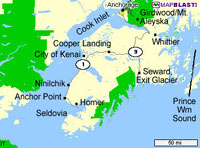Settlements on the Iditarod Trail
Seward

Seward is located on Resurrection Bay, named in 1792, by Alexander Baranof, the Alaska manager of the Russian American Company, while he was exploring the Kenai Peninsula for possible sites for ne settlements. It is said that he named the bay Resurrection, because he first entered it on Easter Sunday. The next year, when he was ordered to build ships in Russian America, he selected Resurrection Bay as the site for the shipyard. In 1794 the first ship to be built in Alaska by the Russians, the Phoenix, was launched. Little more is known about the settlement after 1794. It was abandoned in the 1840's. The city of Seward was founded in 1903 by Alaska Central Railway as the ocean terminus for its proposed railroad to the interior. It was named in honor of William H. Seward, the secretary of state who negotiated the purchase of Alaska from Russia in 1867. The Alaska Central went bankrupt and its successor the Alaska Northern Railway was purchased by the federal government in 1915. It became part of the Alaska Railroad, which the government was building from Seward to Fairbanks.
With the completion of the Alaska Railroad in 1923, Seward became the Gateway City. All passengers and freight destined for South Central and Interior Alaska passed through Seward.
With the discovery of gold in the Iditarod country in 1908, Seward became the winter port for the new gold fields. Thousands of people and tons of gold, mail and supplies were carried over the Iditarod Trail between Seward and the Iditarod mining district. Heavy traffic continued over the trail until the 1920's when mining declined and the airplane began to replace the dog team. A renewed interest in the trail was born with the first running of the Iditarod Sled Dog Race in 1973. In 1978 the Iditarod was made a National Historic Trail with Seward as Mile "0". Seward's economy based on railroading and stevedoring was destroyed by the March 27th, 1964 earthquake. Since then Seward has worked hard to rebuild and diversify its economy. Today in addition to its thriving tourist industry, Seward is home to Alaska Vocational-Technical Center, the Spring Creek Correctional Center, the Sea Life Center and the Kenai Fjords National Park.
Take a walking tour of Mile Zero of the Iditarod National Historic Trail!
Virtually visit Kenai Fjords National Park!
With the completion of the Alaska Railroad in 1923, Seward became the Gateway City. All passengers and freight destined for South Central and Interior Alaska passed through Seward.
With the discovery of gold in the Iditarod country in 1908, Seward became the winter port for the new gold fields. Thousands of people and tons of gold, mail and supplies were carried over the Iditarod Trail between Seward and the Iditarod mining district. Heavy traffic continued over the trail until the 1920's when mining declined and the airplane began to replace the dog team. A renewed interest in the trail was born with the first running of the Iditarod Sled Dog Race in 1973. In 1978 the Iditarod was made a National Historic Trail with Seward as Mile "0". Seward's economy based on railroading and stevedoring was destroyed by the March 27th, 1964 earthquake. Since then Seward has worked hard to rebuild and diversify its economy. Today in addition to its thriving tourist industry, Seward is home to Alaska Vocational-Technical Center, the Spring Creek Correctional Center, the Sea Life Center and the Kenai Fjords National Park.
Take a walking tour of Mile Zero of the Iditarod National Historic Trail!
Virtually visit Kenai Fjords National Park!
